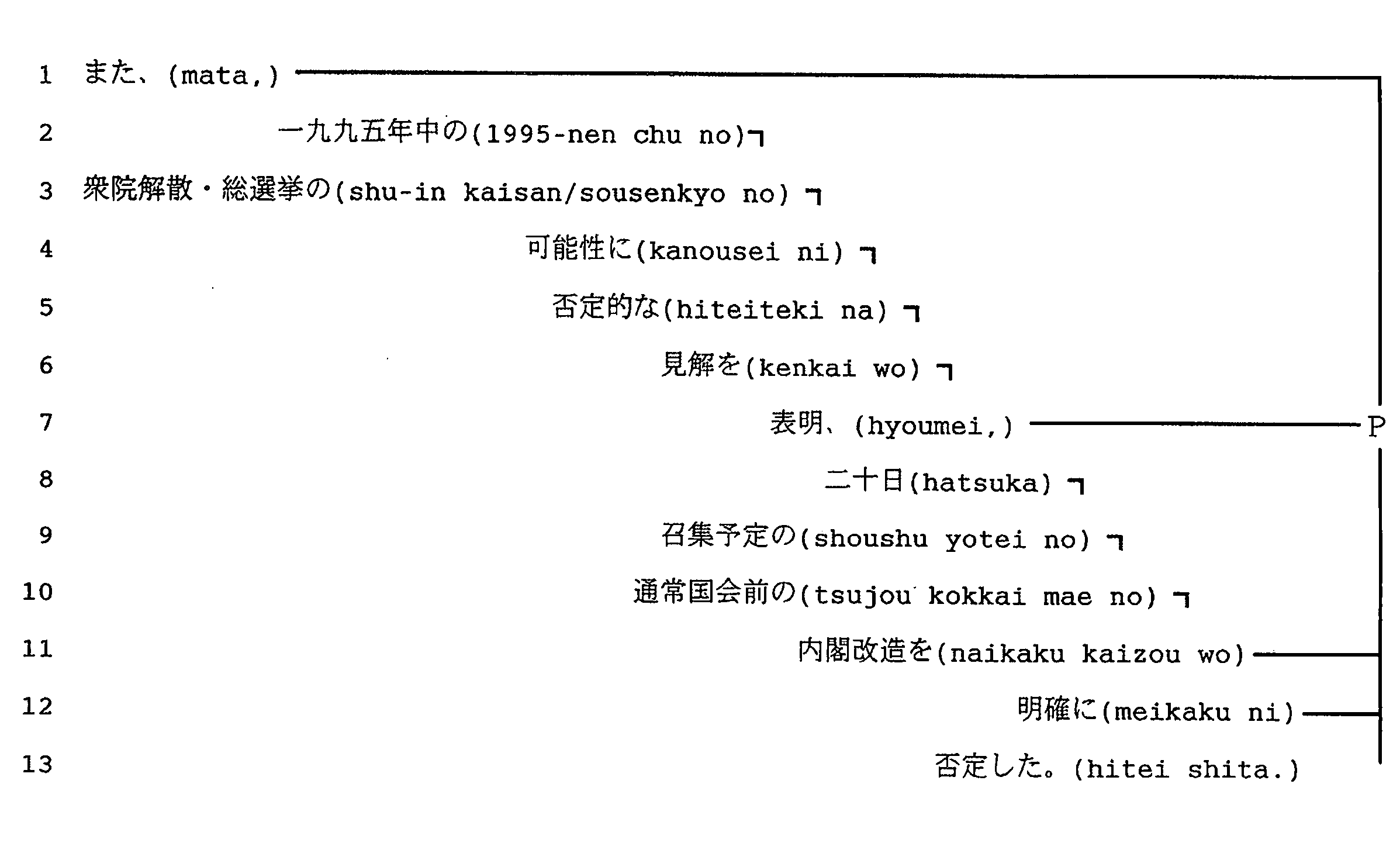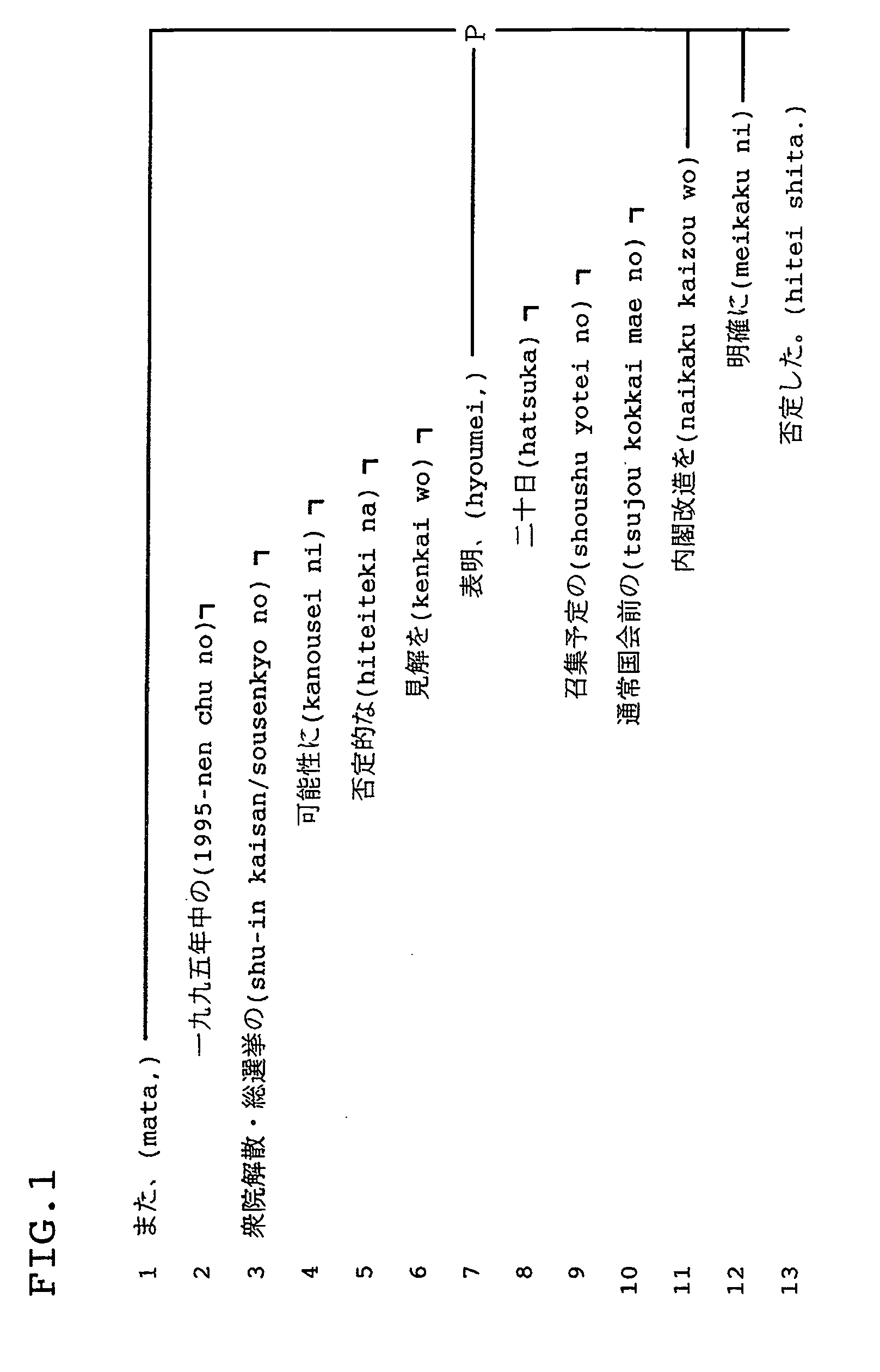Method for generating a text sentence in a target language and text sentence generating apparatus
a text sentence and target language technology, applied in the field of natural language processing, can solve the problems of complicated rules, increased possibility of conflict among rules, and difficulty in arbitrating rules
- Summary
- Abstract
- Description
- Claims
- Application Information
AI Technical Summary
Benefits of technology
Problems solved by technology
Method used
Image
Examples
example 1
[0063]FIG. 2 is a flow chart associated with a target language text sentence generation method according to Example 1 of the present invention. As shown in FIG. 2, when one or more words / phrases 1 in a source language (Japanese) are input as keywords, one or more pairs of a source language sentence including at least one of the input keywords (1) and a translation thereof in a target language (such a pair is referred to simply as a sentence pair) are extracted (2) from the parallel corpus database (10).
[0064] Thereafter, one or more keyword-related words / phrases in the target language corresponding to each keyword included in the extracted sentence pairs are extracted from partial correspondence information (11), and described in a keyword-related phrase table (12). Note that the partial correspondence information (11) is information included in the parallel corpus database (10), the partial correspondence information (11) and the keyword-related phrase table (12) are the same.
[00...
example 2
[0130]FIG. 3 is a flow chart showing processing according to example 2 of the present invention. In the example 2, when a plurality of sentence pairs are extracted (2) for an input Japanese keyword (1), if two or more different Japanese phrases related to the Japanese keyword (1) are extracted from the partial correspondence information associated with the sentence pairs, a correct Japanese keyword-related phrase is selected (20).
[0131] The process is described in further detail with reference to FIG. 9. The translation pair extractor (50) extracts sentence pairs including a Japanese keyword (31) from the parallel corpus database (52). For example, when (kanojo)” is input as a keyword, if (kanojo ga)”, (kanojo to)”, and (kanojo ni)” are extracted as Japanese keyword-related phrases from a plurality of sentence pairs. Then a Japanese phrase candidate presenter (61) presents to a user all these extracted Japanese keyword-related phrases. In response, the user selects a best one f...
example 3
[0135]FIG. 4 is a flow chart showing processing according to example 3 of the present invention. In example 3, when a sentence pair is extracted (2), phrases that co-occur with a keyword are extracted from the sentence pair (21). The extracted co-occurring phrases are presented to a user (22). If the user selects a co-occurring phrase, the selected phrase is employed as a new keyword (1).
[0136] For example, as shown in FIG. 13, at the point of time at which Japanese keywords (kanojo) ” and (kouen) ” have been input, the sentence pair extractor (50) extracts a sentence pair (Kanojo to kouen he itta) / I went to the park with her”, and the co-occurring phrase extractor (66) extracts (itta)” as a co-occurring phrase that co-occurs with (kanojo to)” and (kouen he)”. Techniques to extract co-occurring phrases are known in the art.
[0137] A co-occurring phrase presenter (67) presents (itta)” to the user by displaying it on the monitor (64). When the user determines to employ it as a...
PUM
 Login to View More
Login to View More Abstract
Description
Claims
Application Information
 Login to View More
Login to View More - R&D
- Intellectual Property
- Life Sciences
- Materials
- Tech Scout
- Unparalleled Data Quality
- Higher Quality Content
- 60% Fewer Hallucinations
Browse by: Latest US Patents, China's latest patents, Technical Efficacy Thesaurus, Application Domain, Technology Topic, Popular Technical Reports.
© 2025 PatSnap. All rights reserved.Legal|Privacy policy|Modern Slavery Act Transparency Statement|Sitemap|About US| Contact US: help@patsnap.com



